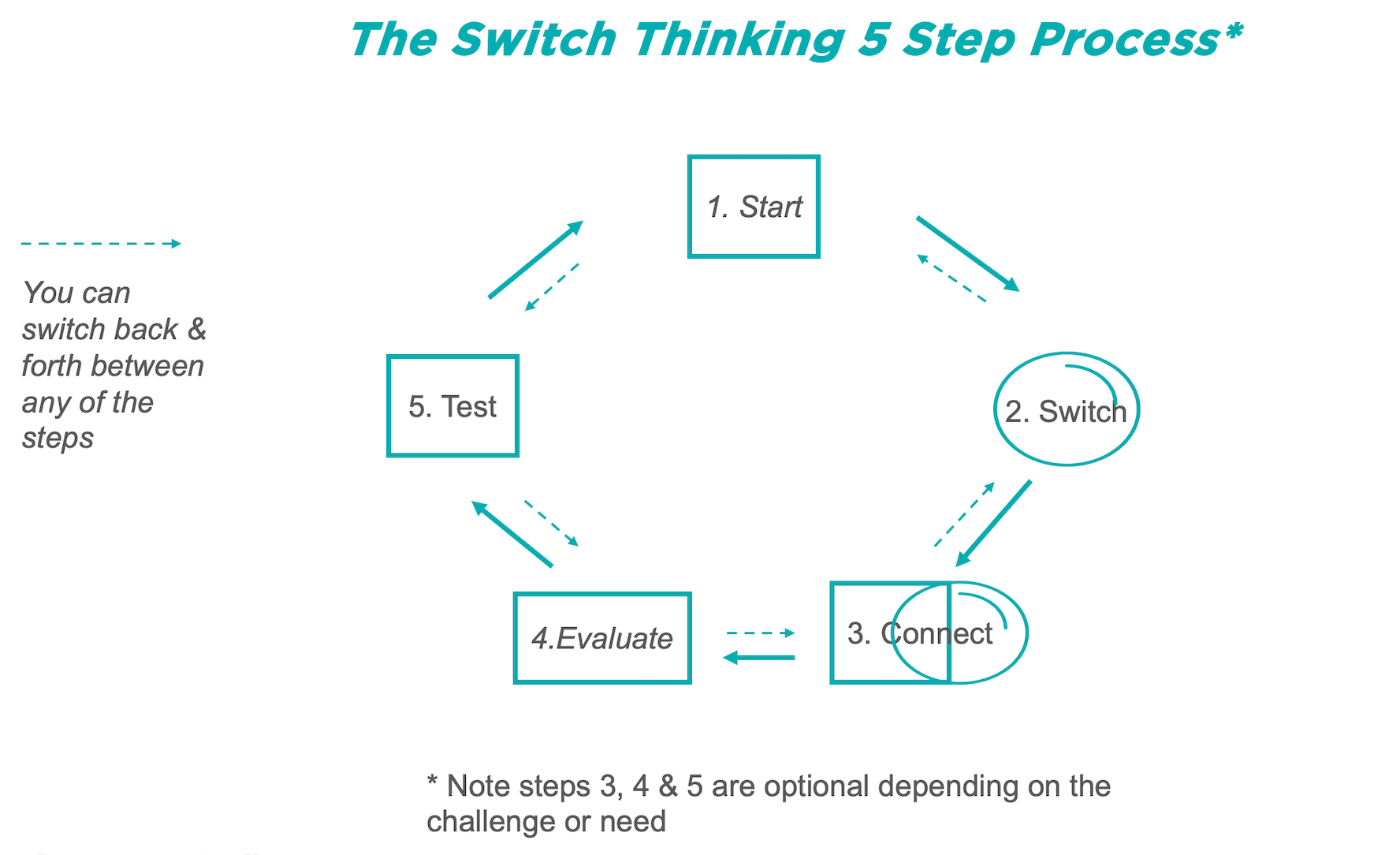The Switch Thinking 5 Step Process is one that I have developed and tested with hundreds of people over the past 18 months.
The good news is that it works for most (if not all types of problems).
People find it easy to follow, gives them a starting point and has a semi-structure that is both creative and efficient.
The Switch Thinking 5 Step process can be used by humans with other humans or with AI.
Here is how the human version works:
Step 1. Start
You start by defining the problem.
Then you try and generate 9 ideas to tackle this problem as fast as you can (ideally in 2 minutes or less).
In this way you get started without overthinking or procrastinating.
The 2 minute – 9 idea framework encourages you to switch from your usual way of thinking (UWOT) to a different way of thinking (DWOT).
Step 2. Switch
Then you select a switch or prompt to develop some different ideas to the problem.
Again try doing this in 2 minutes or less.
For example, you could adopt say a lead singer of a band’s perspective and presto you will see the challenge differently.
You can use by yourself, with a team or using AI.
Step 3. Enhance & Connect
This is an often over-looked step.
You now try (and/or with your group or team) to both enhance and then connect your initial ideas with the switched ideas to develop a bigger, better solution.
In this step you connect what has worked in the past with what might work in the future.
Try and do this step as fast as you can.
Use your intuition and imagination.
Step 4. Evaluate
As the name implied this step is concerned with evaluating all your initial, switched and connected ideas.
You could use impact, budget, appeal, timing etc or any combination to evaluate your ideas.
You can work with the team or with AI.
Step 5: Test
This step takes your best 1-3 ideas and you develop a way to test these potential solutions as quickly, easily and cheaply as possible.
It could be talking informally to some clients or customers, building a prototype or a spreadsheet.
The goal is to try and gain an early reaction to your solution.
By doing so you save money and have a chance to iterate the solution or move on to another solution.
Note you can use all or some of the steps and go back and forth depending on the quality and quantity of your ideas.
The Switch Thinking 5 step process can also be used with any Generative AI tool to co-create new ideas or solutions – quickly.
The 5 steps are exactly the same but rather than working with a human you are interacting with ChatGPT for example.
Here are the 5 steps:
Step 1.
Define the challenge or problem and enter this as a Prompt with Bard or ChatGPT for example.
The prompt could be ‘generate say 9 ideas or solutions to this problem’.
This becomes the UWOT (i.e. usual way of thinking).
Step 2:
Now use any of the 6 Switches or Prompts to develop your DWOT (i.e. different way of thinking).
For example, you could ask ChatGPT (via a prompt) to switch the outcome e.g. what are some solutions that might make a 100% difference to the same problem.
ChatGPT will then generate a new set of ideas.
Ideally these will be more creative and innovative.
Step 3. Connect
As with the human to human variation the goal is to connect the usual to the different ideas to develop a bigger, better solution.
In this case you enter a prompt which is something like: Can you connect your initial ideas to the switched ideas to develop a better solution?
Step 4: Evaluate
In this step you (or the group) ask Chat to evaluate all the ideas on the basis of say impact, appeal or feasibility (or any other criteria you choose).
ChatGPT will then list the ideas according to your criteria.
Step 5.
Now ask ChatGPT to develop a test plan for the top 3 ideas or solutions.
In Summary:
The Switch Thinking 5 step process is quick, easy and it works!
It can be used with humans or with AI or in any combination.
It combines creativity via the switches and prompts with efficiency.
This means that problems can be solved when they emerge rather than waiting for a brainstorming session in 3 weeks time for example.
The Switch Thinking 5 step process can help you develop amazing ideas and solutions, in minutes.
It’s the next level in problem solving that anyone can use, anywhere, anytime, with anyone.

